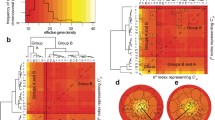Summary
The position and arrangement of individual chromosomes in interphase nuclei were examined in mouse-human cell hybrids by in situ hybridization of biotinylated human DNA probes. Intense and even labeling of human chromosomes with little background was observed when polyethylene glycol and Tween-20 were included in hybridization solutions. Human interphase chromosomes were separated from each other in the nucleus, and were confined to well localized domains. Hybrid cells with a single human chromosome showed a reproducible position of this chromosome in the nucleus. Some chromosomes appeared to have a characteristic folding pattern in interphase. Optical section as well as electron microscopy of labeled regions revealed the presence of 0.2 μm wide fibers in each interphase domain, as well as adjacent, locally extended 500 nm fibers. Such fibers are consistent with previously proposed structural models of interphase chromosomes.
Similar content being viewed by others
References
Adolph K, Cheng S, Laemmli UK (1977) Role of non-histone chromosomal proteins in metaphase chromosome structure. Cell 12: 805–815
Avivi L, Feldman M (1980) Arrangement of chromosomes in the interphase nucleus of plants. Hum Genet 55:281–295
Comings DE (1968) The rationale for an ordered arrangement of chromatin in the interphase nucleus. Am J Hum Genet 20:440–460
Cremer T, Cremer C, Baumann H, Leudtke EK, Sperling K, Teuber V, Zorn C (1982) Rabl's model of the interphase chromosome arrangement tested in Chinese hamster cells by premature chromosome condensation and laser-UV microbeam experiments. Hum Genet 60:46–56
Ellison JR, Howard GC (1981) Non-random position of the A-T rich DNA sequences in early embryos of Drosophila virilis. Chromosoma 83:551–561
Finch JT, Klug A (1976) Solenoidal model for superstructure in chromatin. Proc Natl Acad Sci USA 73:1897–1901
Hens L, Baumann H, Cremer T, Sutter A, Cornelis JJ, Cremer C (1983) Immunocytochemical localization of chromatin regions UV-microirradiated in S phase or anaphase. Exp Cell Res 149: 257–269
Lieberman HB, Rabin M, Barker PE, Ruddle FH, Varshney U, Gedamu L (1985) Human metallothionein-II processed gene is located in region p11–q21 of chromosome 4. Cytogenet Cell Genet 39:109–115
Manuelidis L (1982) Nucleotide sequence definition of a major human DNA, the HindIII 1.9 kb family. Nucleic Acids Res 10:3211–3219
Manuelidis L (1984a) Active nucleolus organizers are precisely positioned in adult central nervous system cells but not in neuroectodermal tumor cells. J Neuropathol Exp Neurol 43:225–241
Manuelidis L (1984b) Different CNS cell types display distinct and nonrandom arrangements of satellite DNA sequences. Proc Natl Acad Sci USA 81:3123–3127
Manuelidis L (1985a) Indications of centromere movement during interphase and differentiation. Ann NY Acad Sci 450:205–221
Manuelidis L (1985b) In situ detection of DNA sequences using biotynylated probes. Focus 7:4–8
Manuelidis L, Ward DC (1984) Chromosomal and nuclear distribution of the HindIII 1.9 kb repeat segment. Chromosoma 91:28–38
Manuelidis L, Sedat J, Feder R (1980) Soft X-ray lithographic studies on interphase chromosomes. Ann NY Acad Sci 342:304–325
Manuelidis L, Langer-Safer PR, Ward DC (1982) High resolution mapping of satellite DNA using biotin-labeled DNA probes. J Cell Biol 95:619–625
Mathog D, Hochstrasser M, Gruenbaum Y, Saumweber H, Sedat J (1984) Characteristic folding pattern of polytene chromosomes in Drosophila salivary gland nuclei. Nature 308:414–421
Moroi Y, Hartman AL, Nakane PK, Tau EM (1981) Distribution of kinetochore (centromere) antigen in mammalian cell nuclei. J Cell Biol 90:254–259
Nicolini C (1983) Chromatin structure: from nuclei to genes (review) Anticancer Res 3:63–86
Rattner JB, Lin CC (1985) Radial loops and helical coils coexist in metaphase chromosomes. Cell 42:291–296
Renz M, Kurz C (1984) A colorimetric method for DNA hybridization. Nucleic Acids Res 12:3435–3444
Sedat J, Manuelidis L (1978) A direct approach to the structure of eukaryotic chromosomes. Cold Spring Harbor Quant Biol XLII: 331–350
Vogel F, Schroeder TM (1974) The internal order of the interphase nucleus. Hum Genet 25:265–297
Author information
Authors and Affiliations
Rights and permissions
About this article
Cite this article
Manuelidis, L. Individual interphase chromosome domains revealed by in situ hybridization. Hum Genet 71, 288–293 (1985). https://doi.org/10.1007/BF00388453
Received:
Issue Date:
DOI: https://doi.org/10.1007/BF00388453




